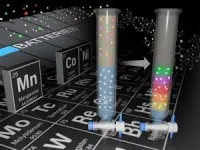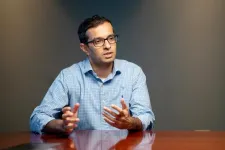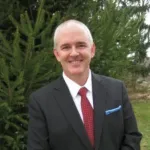(Press-News.org) RICHLAND, Wash.—There’s some irony in the fact that devices that seem indispensable to modern life—mobile phones, personal computers, and anything battery-powered—depend entirely on minerals extracted from mining, one of the most ancient of human industries. Once their usefulness is spent, we typically return these objects to the Earth in landfills, by the millions.
But what if we could “mine” electronic waste (e-waste), recovering the useful minerals contained within them, instead of throwing them away? A clever method of recovering valuable minerals from e-waste, developed by a research team at the Department of Energy’s Pacific Northwest National Laboratory, is showing promise to do just that. Materials separation scientist Qingpu Wang will present recent success in selectively recovering manganese, magnesium, dysprosium, and neodymium, minerals critical to modern electronics, at the 2024 Materials Research Society (MRS) Spring Meeting on April 25, 2024, in Seattle, WA.
Go with the flow
Just as a prism splits white light into a dazzling rainbow of colors based on distinct wavelengths, so too can metals be separated from one another using their individual properties. However, current separation methods are slow, as well as chemical- and energy-intensive. These barriers make the recovery of valuable minerals from e-waste streams economically unfeasible.
In contrast, the PNNL research team used a simple mixed-salt water-based solution and their knowledge of metal properties to separate valuable minerals in continuously flowing reaction chambers.
The method, detailed in two complementary research articles and presented this week, is based on the behavior of different metals when placed in a chemical reaction chamber where two different liquids flow together continuously. The research team exploited the tendency of metals to form solids at different rates over time to separate and purify them.
“Our goal is to develop an environmentally friendly and scalable separation process to recover valuable minerals from e-waste,” said Wang. “Here we showed that we can spatially separate and recover nearly pure rare earth elements without complex, expensive reagents or time-consuming processes.”
The research team, which included materials scientist Chinmayee Subban, who also holds a joint appointment with the University of Washington, first reported in February 2024 successfully separating two essential rare earth elements, neodymium and dysprosium, from a mixed liquid. The two separate and purified solids formed in the reaction chamber in 4 hours, versus the 30 hours typically needed for conventional separation methods. These two critical minerals are used to manufacture permanent magnets found in computer hard drives and wind turbines, among other uses. Until now, separating these two elements with very similar properties has been challenging. The ability to economically recover them from e-waste could open up a new market and source of these key minerals.
Recovering minerals from e-waste is not the only application for this separation technique. The research team is exploring the recovery of magnesium from sea water as well as from mining waste and salt lake brines.
“Next, we are modifying the design of our reactor to recover a larger amount of product efficiently,” added Wang.
Recovering manganese from simulated battery waste
Using a complementary technique, Wang and his colleague Elias Nakouzi, a PNNL materials scientist, showed that they can recover nearly pure manganese (>96%) from a solution that mimics dissolved lithium-ion battery waste. Battery-grade manganese is produced by a handful of companies globally and is used primarily in the cathode, or negative pole of the battery.
In this study, the research team used a gel-based system to separate the materials based on the different transport and reactivity rates of the metals in the sample.
“The beauty in this process is its simplicity,” Nakouzi said. “Rather than relying on high-cost or specialty materials, we pared things back to thinking about the basics of ion behavior. And that’s where we found inspiration.”
The team is expanding the scope of the research and will be scaling up the process through a new PNNL initiative, Non-Equilibrium Transport Driven Separations (NETS), which is developing environmentally friendly new separations to provide a robust, domestic supply chain of critical minerals and rare earth elements.
“We expect this approach to be broadly relevant to chemical separations from complex feed streams and diverse chemistries—enabling more sustainable materials extraction and processing,” said Nakouzi.
The research studies reported at MRS received support from a Laboratory Directed Research and Development Program and the NETS initiative at PNNL.
Learn more about materials sciences careers at PNNL.
END
Critical minerals recovery from electronic waste
PNNL researchers achieve sustainable recovery of minerals from e-waste
2024-04-24
ELSE PRESS RELEASES FROM THIS DATE:
The move by Apple Memories to block potentially upsetting content illustrates Big Tech’s reach and limits, writes Chrys Vilvang
2024-04-23
How do algorithms determine the way we interact with our memories?
It’s a uniquely 21st-century kind of question, and it is far from settled.
In a new paper in the journal Memory, Mind & Media, Concordia PhD candidate Chrys Vilvang argues that the way tech companies store, package and share personal content back to users is opaque. And, given one recent controversy, it’s open to important questions about selection and representation.
Vilvang’s paper looks at the discussion stemming from an April 2022 article on 9to5Mac, a tech news site dedicated to all things Apple. Its journalists were given access to the iOS 15.5 beta update, and they discovered ...
Chemical tool illuminates pathways used by dopamine, opioids and other neuronal signals
2024-04-23
Image
University of Michigan researchers have developed a new tool to better understand how chemicals like dopamine and epinephrine interact with neurons.
These chemicals are among a wide variety of signals that get processed in the brain through G protein-coupled receptors (GPCRs), proteins that sit on the surface of neurons to receive messages—in the forms of proteins, sugars, fats, even light—that inform cellular behavior.
GPCRs are involved in an enormous number of biological functions, making them a prime ...
Asian monsoon lofts ozone-depleting substances to stratosphere
2024-04-23
Asian monsoon lofts ozone-depleting substances to stratosphere
Airborne observations discover new link between pollution and climate
Powerful monsoon winds, strengthened by a warming climate, are lofting unexpectedly large quantities of ozone-depleting substances high into the atmosphere over East Asia, new research shows.
The study, led by the U.S. National Science Foundation National Center for Atmospheric Research (NSF NCAR) and NASA, found that the East Asian Monsoon delivers more than twice the concentration of very short-lived ozone-depleting substances into the upper troposphere and lower stratosphere than previously reported.
The research team ...
PET scans reveal ‘smoldering’ inflammation in patients with multiple sclerosis
2024-04-23
A Brigham and Women’s Hospital study of 30 people found that, in patients with MS, advanced brain imaging could identify hidden inflammation not picked up on traditional MRIs
The new technique could lead to more advanced treatments for multiple sclerosis
A new study from Brigham and Women’s Hospital, a founding member of the Mass General Brigham healthcare system, suggests positron emission tomography (PET) brain scans could reveal hidden inflammation in patients with multiple sclerosis (MS) who are being treated with highly-effective treatments. The findings were published ...
Genetics predict type 2 diabetes risk and disparities in childhood cancer survivors
2024-04-23
(MEMPHIS, Tenn. – April 23, 2024) Survivors of childhood cancer are at increased risk for cardiovascular disease, for which a risk factor is their greater prevalence of type 2 diabetes, with a disproportionate impact on those of non-European heritage. St. Jude Children’s Research Hospital scientists have identified four previously unknown genetic variants associated with diabetes risk in all survivors. Published today in the Journal of Clinical Oncology, their work also found an association between a previously ...
Health information on TikTok: The good, the bad and the ugly
2024-04-23
In today's digital age, social media platforms like TikTok have become integral parts of our lives, offering not just entertainment and catchy dances but also a wealth of information on topics ranging from home improvement to world news. According to some reports, many young people even prefer to use social media in place of traditional search engines like Google when looking for answers.
Health information is no exception. Hashtags like #celiactok, #diabetestok and #sinustok have millions of views, with each tag leading to countless videos about each health issue.
“Every type of ‘Tok’ exists – that’s just ...
New study points to racial and social barriers that block treatment for multiple myeloma
2024-04-23
A UC Davis Health study reveals persistent racial and social disparities preventing access to autoHCT, a common bone marrow transplant treatment to halt the progression of multiple myeloma.
An analysis of data from three California health care organizations, published in Clinical Lymphoma, Myeloma & Leukemia, showed that Black myeloma patients were less likely to receive autoHCT. This was despite having a greater risk of developing the cancer than other racial or ethnic groups. Patients using Medicaid, Medicare, or no insurance in California also accessed the treatment less than those with other insurance ...
Rensselaer researcher finds that frog species evolved rapidly in response to road salts
2024-04-23
When we think of evolution, we think of a process that happens over hundreds or thousands of years. In research recently published, a team led by Rick Relyea, Ph.D., professor of biological sciences and David M. Darrin ’40 Senior Endowed Chair at Rensselaer Polytechnic Institute, found a species of frog that has evolved over the course of merely 25 years. The adaptation was spurred on by something many assume is innocuous: salt.
“We’ve been applying de-icing salts to reduce car accidents in snowy and icy conditions in the United States for 80 years, and we currently apply four times more road salt than we did ...
A new chapter in quantum vortices: Customizing electron vortex beams
2024-04-23
A new publication from Opto-Electronic Advances; DOI 10.29026/oea.2024.230184 , discusses tailoring electron vortex beams with customizable intensity patterns by electron diffraction holography.
In recent years, the scientific community has witnessed a notable breakthrough in the study and development of electron vortices. Electron vortices are electron beams that carry orbital angular momentum, meaning the electrons move not only in their propagation direction but also rotate in a vortex-like manner. This unique characteristic offers many new physical properties and potential applications, making it a powerful ...
Don’t be a stranger – study finds rekindling old friendships as scary as making new ones
2024-04-23
sychologists from Simon Fraser University (SFU) and the University of Sussex have found that people are as hesitant to reach out to an old friend as they are to strike up a conversation with a stranger, even when they had the capacity and desire to do so. The new research is published today in the journal Nature Communications Psychology.
Scientific research has shown that social relationships are important to human happiness, and that the greater the number and range of friendships that we engage with, the better our wellbeing. But once relationships are formed, some ...
LAST 30 PRESS RELEASES:
Scientists trace microplastics in fertilizer from fields to the beach
The Lancet Obstetrics, Gynecology, & Women’s Health: Taking paracetamol during pregnancy does not increase risk of autism, ADHD or intellectual disabilities, confirms new gold-standard evidence review
Taking paracetamol during pregnancy does not increase risk of autism, ADHD or intellectual disabilities
Harm reduction vending machines in New York State expand access to overdose treatment and drug test strips, UB studies confirm
University of Phoenix releases white paper on Credit for Prior Learning as a catalyst for internal mobility and retention
Canada losing track of salmon health as climate and industrial threats mount
Molecular sieve-confined Pt-FeOx catalysts achieve highly efficient reversible hydrogen cycle of methylcyclohexane-toluene
Investment in farm productivity tools key to reducing greenhouse gas
New review highlights electrochemical pathways to recover uranium from wastewater and seawater
Hidden pollutants in shale gas development raise environmental concerns, new review finds
Discarded cigarette butts transformed into high performance energy storage materials
Researchers highlight role of alternative RNA splicing in schizophrenia
NTU Singapore scientists find new way to disarm antibiotic-resistant bacteria and restore healing in chronic wounds
Research suggests nationwide racial bias in media reporting on gun violence
Revealing the cell’s nanocourier at work
Health impacts of nursing home staffing
Public views about opioid overdose and people with opioid use disorder
Age-related changes in sperm DNA may play a role in autism risk
Ambitious model fails to explain near-death experiences, experts say
Multifaceted effects of inward foreign direct investment on new venture creation
Exploring mutations that spontaneously switch on a key brain cell receptor
Two-step genome editing enables the creation of full-length humanized mouse models
Pusan National University researchers develop light-activated tissue adhesive patch for rapid, watertight neurosurgical sealing
Study finds so-called super agers tend to have at least two key genetic advantages
Brain stimulation device cleared for ADHD in the US is overall safe but ineffective
Scientists discover natural ‘brake’ that could stop harmful inflammation
Tougher solid electrolyte advances long-sought lithium metal batteries
Experts provide policy roadmap to reduce dementia risk
New 3D imaging system could address limitations of MRI, CT and ultrasound
First-in-human drug trial lowers high blood fats
[Press-News.org] Critical minerals recovery from electronic wastePNNL researchers achieve sustainable recovery of minerals from e-waste






